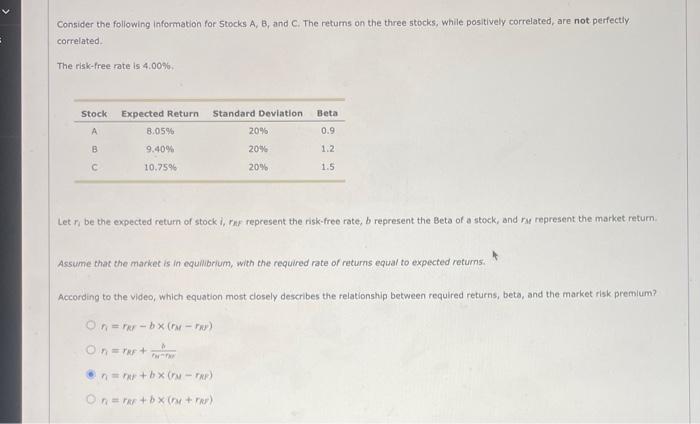Consider the following information for 5tocks A,B, and C. The returns on the three stocks, while positively correlated, are not perfectly correlated. The risk-free rate is 4.00% Let r, be the expected return of stock 1,rn represent the risk-free rate, b represent the Beta of a stock, and rM represent the market return. Assume that the market is in equilibrium, with the required rate of returns equal to expected returns. According to the video, which equation most dosely describes the relationship between required returns, beta, and the market risk premium? rn=rNrb(rMrN)nn=rRr+nMrMbrn=rMr+b(rMrNE)rr=rR+b(rM+rNr) Hint: Recall that because the market is in equilibrium, the required rate of return is equal to the expected rate of return for each stock. Using the equation you just identified, you can solve for the market risk premium which, in this case, equals approximately Consider Fund P, which has one third of its funds invested in each of stock A,B, and C. True or False: The beta for a fund is equal to the weighted average of the betas of the individual stocks in the fund. True False Using your answer to the previous question, the beto for Fund P is approximately You have the market risk premium, the beta for Fund P, and the risk-free rate. Nint: Recall that because the market is in equilibrium, the required rate of return is equal to the expected rate of return for each stock: This information implles that the required rate of return for Fund P is approximately True or False: The standard deviation for Fund P is less than 20%. True False Now it's time for you to practice what you've learned. Consider the following information for Stocks A,B, and C. The retums on the three stocks, while positively correlated, are not perfectly correlated. The risk-free rate is 4.00%. Let r, be the expected return of stock i,r re represent the risk-free rate, b represent the Beta of a stock, and r, represent the market return. Using SML equation, you can solve for the market risk premium which, in this case, equals approximately Consider Fund P, which has one third of its funds invested in each of stock A,B, and C. The beta for Fund P is approximately You have the market risk premium, the beta for Fund P, and the risk-free rate. Hint: Recall that because the market is in equilibrium, the required rate of retum is equal to the expected rate of roturn for each stock. This information implies that the required rate of return for Fund p is approximately Hint: Recall that because the market is in equitibrium, the required rate of return is equal to the expected rate of return for each stock. This information implies that the required rate of return for Fund P is approximately Which of the following is the reason why the standard deviation for Fund P is less than 20%6 ? The stocks in Fund P are perfectly correlated. The stocks in Fund P are not perfectly correlated. The stocks in Fund P each have differing standard deviations. Any two stocks in Fund P have a correlotion coefficient of 1










